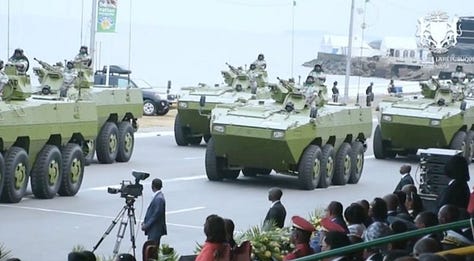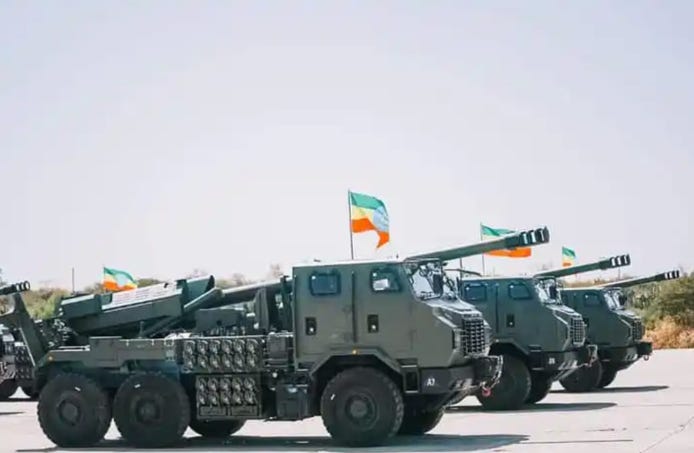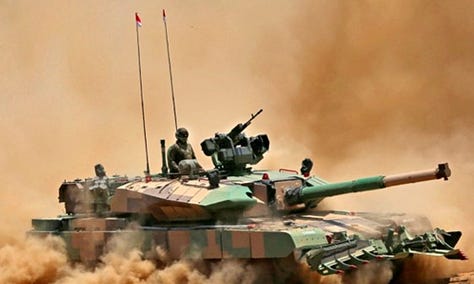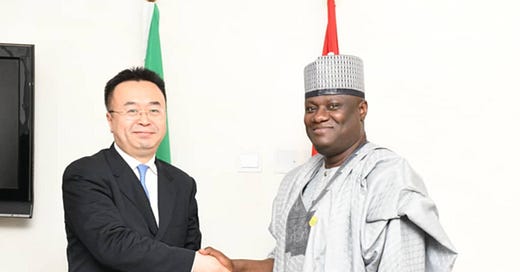China and India Competition in Africa Extends to Arms Exports
China and India increasing focus on arms exports and technology transfers to African countries reflects the importance each country views the region.


In September 2023, India and Nigeria signed a deal worth $1 billion USD (₹83.2 billion Indian Rupees) to assist the latter’s defense industry. The deal involves India’s Defense Ministry assisting the Defence Corporation of Nigeria (DICON) to become 40 percent self-sufficient in military equipment production by 2027. However, Nigeria and China began talks in November 2023 to expand arms production, technology transfers, and training between the two countries. The competing talks between Nigeria, China and India illustrates how both countries are using arms production and technology transfers to expand their influence in Africa.






China’s Strategy
China’s strategy of gaining influence through arms sales and technology transfers is rooted in its history of providing aid to revolutionary groups in the 1960s and 1970s. However, these groups were mainly limited to countries in both eastern and southern Africa such as Mozambique, Zimbabwe, and Angola. After 1979, China transitioned to official equipment and weapon sales to these countries due to the country opening to western investment. Another reason for the move to formal weapon sales is due to the same groups it previously assisted were now the ruling power in the countries. One region that China saw little success in the 1980s and 1990s was West Africa due to the lack of historical connections and the region’s overall political instability during this time. However, China sold some weapon systems – including Infantry Fighting Vehicles (IFVs) and Unmanned Aerial Systems (UASs) – to West African countries such as Gabon and Nigeria in the early 2000s. However, the country then made significant inroads into West Africa in the early 2020s due to the decline in French influence and Russia’s inability to fulfill weapon contracts due to sanctions. China sold jet aircraft, MRAPs, IFVs, and UASs to Nigeria but also other countries such as Mali, Benin, and Senegal.


One aspect that make Chinese weapon systems attractive to African countries is due to their lower price compared to western counterparts or equivalents. Furthermore, China will also sell weapons to these countries using Chinese financed loans to protect Belt and Road Initiative (BRI) projects. While the country utilizes Chinese Private Military and Security Companies (PMSCs) to protect the BRI projects, Chinese laws prohibit the guards from carrying weapons while in country. These contractors depend on either local military forces or companies that they will arm and equip with Chinese weapons and hardware. China will also sell military equipment and hardware to countries with no ‘strings’ attached such as prohibitions on their use or their sale due to a history of human rights abuses. For example, China sold 32 export variants of the PCL-181 wheeled howitzers to Ethiopia in early 2023 after the Tigray conflict concluded. Ethiopia chose the PCL-181s since China allowed the howitzer’s sale even if former had several allegations of human rights violations due to the Tigray conflict.



China also donates a significant amount of military equipment to African countries and African Union (AU) and other regional organization’s peacekeeping missions. China donated approximately $28 million USD (198.6 million 元) in military equipment to Zimbabwe in December 2023 to help country to continue its military modernization. The donation of armored vehicles, patrol boats, personal carriers, and various small arms would also enable Zimbabwe to increase its military’s capabilities to conduct security operations. In March 2023, China also donated four surveillance drones to Benin to improve its surveillance capabilities to combat criminal and Islamic terrorist activity in the country. Regarding donations to AU and other organizations peacekeeping missions, the country made significant donations of hardware and equipment to the missions in recent times. China donated approximately $100 million USD (709.3 million 元) to the Southern African Development Community (SADC) Mission in Mozambique (SAMIM) in November 2023. The donation is the third allotment China made to the mission and consisted of armored vehicles, MRAPs, utility trucks, and protective gear such as ballistic vests.


India’s Strategy
India’s strategy differs radically from China’s because the country focuses on a few African countries that would enable it to build up its influence in the continent over time. Specifically, India’s strategy is based on three aspects, the first is to provide quality equipment and hardware to African countries with cheaper procurement and operation costs. Several countries – such as Nigeria and Kenya – showed an interest in several of Indian made aircraft and systems as the Light Combat Aircraft (LCA) Tejas and the Light Combat Helicopter (LCH) Prachand. This aspect also extends to technology transfers of military equipment such as armored vehicles, personal gear, and various vessels. For example, Kenya and India signed a Memorandum of Understanding (MOU) in August 2023 to increase collaboration on ship construction and design that also extends to technology transfers. The MOU will also allow Kenya Shipyards Limited (KSL) to benchmark Goa Shipyard Limited’s experience regarding how they would modernize various aspects of their shipyard located in Mombasa.



Another aspect of India’s strategy is to extend credit lines to any African country committed to buying Indian produced equipment. In April 2023, India extended a $14 billion USD (₹1.2 trillion Indian Rupees) to 42 African countries during the first India-Africa Army Chiefs’ Conclave. India said the countries could use the credit line to buy Indian made equipment to increase their defense and security capabilities. The country also said it wants to become a true cooperation partner with African countries and the credit line is to show the country is a willing partner to the continent. India also held a display of the various military equipment it produces – such as the Arjun Mk1A Main Battle Tank and the Advanced Towed Artillery Gun System (ATAGS) – during the conclave. Several African military officers voiced their interest in several of systems on display but were also open to having a favorable line of credit extended to their countries.

The final aspect of India’s strategy is to donate equipment to African countries that would directly benefit from its use. The most notable example is India’s donation of various equipment – such as SUVs and fast interceptor boasts – to Mozambique beginning in 2019. India donated the SUVs and the boats to increase Mozambique’s coastal surveillance capabilities to combat terrorist groups in the country in July 2019. The country donated a further two fast interceptor boats in 2022 to replace a vessel lost during an August 2020 attack on Mocimboa da Praia by Islamic State Mozambique militants.
Analysis: While the competition between China and India over arms exports and technology transfers will intensify, both countries will face significant obstacles in winning contracts. China’s most significant obstacle is the criticism it faces due to the low quality of the export variants of its military equipment. In 2020, Gabon faced enormous difficulties related to maintaining the five VN-1 IFVs deployed to the Central African Republic in support of the U.N. peacekeeping mission. The VN-1’s transmission system had several mechanical issues that prevented the peacekeepers from conducting patrols and other missions. The contingent’s mechanics would need to have parts delivered from China and create dedicated facilities in the capital of Bangui to repair the IFVs. Another example is various countries reported their Chinese made UAVs crashing or falling out of the sky in the mid-2010s due to landing or other mechanical issues due to low quality manufacturing. Issues related to procuring spare parts and related equipment from Chinese manufacturers is another obstacle China faces. The Gabon example illustrate that China will only deliver the bare minimum called for in the contracts and the countries will need to order new parts from China if they require them.
Analysis: While the competition between China and India over arms exports and technology transfers will intensify, both countries will face significant obstacles in winning contracts. China’s most significant obstacle is the criticism it faces due to the low quality of the export variants of its military equipment. In 2020, Gabon faced enormous difficulties related to maintaining the five VN-1 IFVs deployed to the Central African Republic in support of the U.N. peacekeeping mission. The VN-1’s transmission system had several mechanical issues that prevented the peacekeepers from conducting patrols and other missions. The contingent’s mechanics would need to have parts delivered from China and create dedicated facilities in the capital of Bangui to repair the IFVs. Another example is various countries reported their Chinese made UAVs crashing or falling out of the sky in the mid-2010s due to landing or other mechanical issues due to low quality manufacturing. Issues related to procuring spare parts and related equipment from Chinese manufacturers is another obstacle China faces. The Gabon example illustrate that China will only deliver the bare minimum called for in the contracts and the countries will need to order new parts from China if they require them.
Another issue is China’s previous hesitancy to allow technology transfers to occur with African countries to help develop their own defense industry. China hesitance stems from not wanting countries to develop their own defense base that could allow them to become self-sufficient but instead continue to rely on the country for equipment. Furthermore, China is also hesitant to allow technology transfers to occur because of its mistrust of countries that are not their partners such as Pakistan. However, China’s discussions with Nigeria to help develop their defense base indicates that the country is slowly understanding that African countries want to domestically produce equipment. They also understand that India is willing to transfer technologies to African countries that would allow them to become self-sufficient to varying degrees.
Regarding the obstacles that India faces, the main one is the equipment’s lack proven effectiveness on the battlefield. The various equipment – such as the ATAGS, ACH Prachand, and LCA Tejas – are recently developed systems that are yet to be used in battle by India. The lack of proven effectiveness will make countries uneasy at the thought of buying or taking out loans to acquire equipment found to be ineffective. Furthermore, countries would not want to waste time in developing tactics and doctrine around systems that would be ineffective and would rather buy equipment with a proven track record. Another issue is India’s relative lack of experience in conducting follow-on maintenance and supplying spare parts for equipment countries brought. India’s experience with Ecuador with the Dhruv helicopter in the mid-2010s allowed the country to develop the adequate supply chains necessary to fully deliver on any future contracts.
Another obstacle that India would face is the potential to lose sensitive technologies to potential adversaries such as Pakistan and China after they transfer them to African countries. The various African countries would face significant issues in safeguarding sensitive technologies provided by India due to lack of adequate cybersecurity capability. The lack of a robust capability means that the African countries would be vulnerable to computer network operations aimed at stealing this technology. While India could also assist in developing African countries’ cybersecurity capabilities, it would take time for the countries to develop adequate capabilities to guard against cyberattacks.



